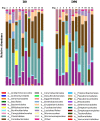The effect of phenobarbital treatment on behavioral comorbidities and on the composition and function of the fecal microbiome in dogs with idiopathic epilepsy
- PMID: 35990279
- PMCID: PMC9386120
- DOI: 10.3389/fvets.2022.933905
The effect of phenobarbital treatment on behavioral comorbidities and on the composition and function of the fecal microbiome in dogs with idiopathic epilepsy
Abstract
Phenobarbital (PB) is one of the most important antiseizure drugs (ASDs) to treat canine idiopathic epilepsy (IE). The effect of PB on the taxonomic changes in gastrointestinal microbiota (GIM) and their functions is less known, which may explain parts of its pharmacokinetic and pharmacodynamic properties, especially its antiseizure effect and drug responsiveness or drug resistance as well as its effect on behavioral comorbidities. Fecal samples of 12 dogs with IE were collected prior to the initiation of PB treatment and 90 days after oral PB treatment. The fecal samples were analyzed using shallow DNA shotgun sequencing, real-time polymerase chain reaction (qPCR)-based dysbiosis index (DI), and quantification of short-chain fatty acids (SCFAs). Behavioral comorbidities were evaluated using standardized online questionnaires, namely, a canine behavioral assessment and research questionnaire (cBARQ), canine cognitive dysfunction rating scale (CCDR), and an attention deficit hyperactivity disorder (ADHD) questionnaire. The results revealed no significant changes in alpha and beta diversity or in the DI, whereas only the abundance of Clostridiales was significantly decreased after PB treatment. Fecal SCFA measurement showed a significant increase in total fecal SCFA concentration and the concentrations of propionate and butyrate, while acetate concentrations revealed an upward trend after 90 days of treatment. In addition, the PB-Responder (PB-R) group had significantly higher butyrate levels compared to the PB-Non-Responder (PB-NR) group. Metagenomics of functional pathway genes demonstrated a significant increase in genes in trehalose biosynthesis, ribosomal synthesis, and gluconeogenesis, but a decrease in V-ATPase-related oxidative phosphorylation. For behavioral assessment, cBARQ analysis showed improvement in stranger-directed fear, non-social fear, and trainability, while there were no differences in ADHD-like behavior and canine cognitive dysfunction (CCD) scores after 90 days of PB treatment. While only very minor shifts in bacterial taxonomy were detected, the higher SCFA concentrations after PB treatment could be one of the key differences between PB-R and PB-NR. These results suggest functional changes in GIM in canine IE treatment.
Keywords: behavioral comorbidities; butyrate; canine idiopathic epilepsy; gastrointestinal microbiota; phenobarbital; short-chain fatty acids.
Copyright © 2022 Watanangura, Meller, Suchodolski, Pilla, Khattab, Loderstedt, Becker, Bathen-Nöthen, Mazzuoli-Weber and Volk.
Conflict of interest statement
Author HV served as a paid consultant in the field of epilepsy for Boehringer Ingelheim, CEVA Animal Health, Nestle Purina, and as a contract researcher for Nestle Purina, Desitin Pharma, and Boehringer Ingelheim. Author JS is an employee of the Gastrointestinal Laboratory at Texas A&M University that provides microbiome testing on a fee-for-service basis and is on the scientific advisory board for Nestle Purina and received speaker honoraria from Royal Canin, Nutramax Laboratories, ExeGi Pharma, LLC, and Hill's Pet Nutrition, Inc. The remaining authors declare that the research was conducted in the absence of any commercial or financial relationships that could be construed as a potential conflict of interest.
Figures






